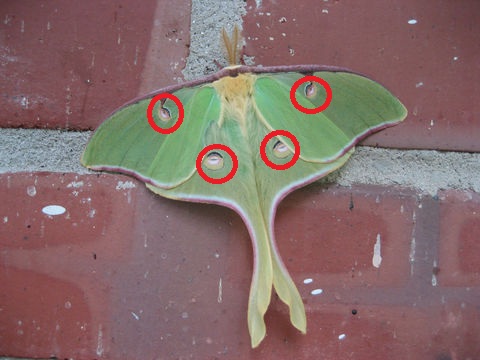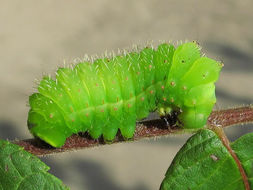Adaptation
The luna moth is clearly still kickin, which means it must have some evolutionary adaptations that allow for its continued existence. Some of these adaptations are morphological, and some are related to lifestyle habits, but all have helped the luna moth to fend off predators and continue to reproduce.

One of the visible adaptations is the four large eyespots
located on the luna moth wings. These large colored scales are
meant to confuse predators into thinking that the luna moth is
even larger than it is. The sheer size of the luna moth is also
an easily noticed adapted characteristic that again makes its
predators think it is a large dangerous animal, and not just a
small moth. (butterfliesandmoths.org)
The most advantageous adaptation the luna moth possesses would be its green coloration in both the caterpillar and adult stages. As a caterpillar, it is mobile, but barely. Blending in so well with leaves and other foliage helps to camouflage the caterpillar while it is trying to eat and grow. As an adult, the luna moth is only really active at night, but during the day it doesn't just disappear. It rests in its habitat of shrub and foliage and also blends in extremely well. This helps to protect the adult and the caterpillar from being preyed upon.
One of the more interesting adaptations
is seen in the luna
 moth
caterpillar. The caterpillar can make a clicking noise with its
mandibles and also spit up yucky food when a threat is sensed.
Both of these actions discourage predators from consuming the
otherwise extremely vulnerable caterpillar.
(butterfliesandmoths.org) Another adaptation on the caterpillar
is the spiny tubercules. This small spike looking hairs are
there to make the caterpillar look less apetizing to a hungry
predator.
moth
caterpillar. The caterpillar can make a clicking noise with its
mandibles and also spit up yucky food when a threat is sensed.
Both of these actions discourage predators from consuming the
otherwise extremely vulnerable caterpillar.
(butterfliesandmoths.org) Another adaptation on the caterpillar
is the spiny tubercules. This small spike looking hairs are
there to make the caterpillar look less apetizing to a hungry
predator.
This organism has multiple impressive adaptation that allow for it to survive and reproduce successfully. Its bright green color is not only beautiful, but is nature's best camouflage as well.
To link to the luna moth Homepage, click
here.
To read some interesting facts about the luna moth, click
here.
To learn more about the reproduction of the luna moth, click
here.
To view the gallery, click here.